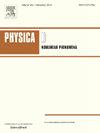Compressibility effects on mixing layer in Rayleigh–Taylor turbulence
IF 2.7
3区 数学
Q1 MATHEMATICS, APPLIED
引用次数: 0
Abstract
The compressibility effects on the mixing layer are examined in Rayleigh–Taylor (RT) turbulence via direct numerical simulation at a high Atwood number of 0.9 and three typical Mach numbers (0.32, 0.71, and 1). The focus has been on the evolution of the mixing layer and the generation of kinetic energy. Specifically, a novel finding emerges at high Atwood number, where enhanced compressibility with increasing Mach number leads to a mean flow directed opposite to gravity in front of the bubble mixing layer. This mean flow, induced by compressibility, causes the width of the bubble layer in compressible RT turbulence to deviate from the quadratic growth observed in the incompressible case. It is further established that this deviation can be modeled by dilatation within the mean flow region. Moreover, the compressibility significantly influences the generation of global kinetic energy at high Mach numbers. The global kinetic energy of RT turbulence with high compressibility is primarily derived from the conversion of internal energy through pressure-dilatation work, rather than from the conversion of potential energy. It is also revealed that the mean flow leads to the conversion of kinetic energy into potential energy, while the fluctuating flow converts the potential energy into kinetic energy within the mixing layer.
求助全文
约1分钟内获得全文
求助全文
来源期刊

Physica D: Nonlinear Phenomena
物理-物理:数学物理
CiteScore
7.30
自引率
7.50%
发文量
213
审稿时长
65 days
期刊介绍:
Physica D (Nonlinear Phenomena) publishes research and review articles reporting on experimental and theoretical works, techniques and ideas that advance the understanding of nonlinear phenomena. Topics encompass wave motion in physical, chemical and biological systems; physical or biological phenomena governed by nonlinear field equations, including hydrodynamics and turbulence; pattern formation and cooperative phenomena; instability, bifurcations, chaos, and space-time disorder; integrable/Hamiltonian systems; asymptotic analysis and, more generally, mathematical methods for nonlinear systems.
 求助内容:
求助内容: 应助结果提醒方式:
应助结果提醒方式:


